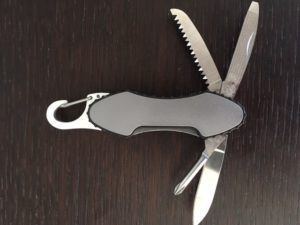08 May The Swiss Army Knife of Difficult Conversation Tools
 Recently I wrote a series of blogs on various ‘challenging’ personalities you might encounter in the workplace – Hooked on Being Right, Do You Know this Person? Is this Guy in Your Organization? Divide and Conquer. I got feedback from a couple of people that they wanted me to give some more specific ways on how to handle these challenging people in the workplace.
Recently I wrote a series of blogs on various ‘challenging’ personalities you might encounter in the workplace – Hooked on Being Right, Do You Know this Person? Is this Guy in Your Organization? Divide and Conquer. I got feedback from a couple of people that they wanted me to give some more specific ways on how to handle these challenging people in the workplace.
Of course, I did provide some ideas about how to manage each difficult character but no specifics. The reason for that is that there is no one technique; there are different tools for different situations and contexts that you may encounter with that temperament. But the other reason was, it is a little difficult to explain the concept of significance positioning, which takes a whole chapter in my international best-selling book, Emotional Judo®: Communication Skills to Handle Difficult Conversations and Boost Emotional Intelligence.
In that chapter, I use the metaphor of laying out four judo mats like quadrants in a square. There are then some judo moves to make sure you stay in the positive areas of relationship. This isn’t just to be a yes person. In fact, it is the opposite. It is a way of getting leverage in a relation ship similarly to the way a judoka (judo competitor) might get leverage in a judo throw.
The best example of this process, from the ten Emotional Judo® tools in the book, is a strategy called EASE. EASE is a four-step process that is like the swiss army knife of difficult conversation tools. It can be used to say “no” diplomatically, to negotiate win-win outcomes, to de-escalate emotional situations, to handle objections in sales, to deftly manage the seven sneaky tricks of difficult conversations, and to deal with various challenging personalities.
I can give you the four steps right now, but my concern is that some people will dismiss them as too simplistic. Although the four steps of EASE are easy once you know how, there are some subtleties that should be known before you try them.
For instance, the first step is to ‘Empathise’ with the other person. Many women are taught to sympathise rather than empathise and some men are taught not to go near their feelings at all. As a result, there is confusion about what empathy is and how to do it. You need to learn the best way to state an empathy statement, so it will be more effective in helping the other person to calm their energy they have brought into the system.
So, rather than just give you the four steps here, I am going to give you the whole mini-book Emotional Judo®: EASE for Difficult Conversations for FREE. It will give you the four steps in detail and more.
If you would like to know how to: say “no” diplomatically, negotiate win-win outcomes, de-escalate emotional situations, and deal with challenging personalities get your FREE copy at https://www.emotionaljudo.com/skele2/


No Comments